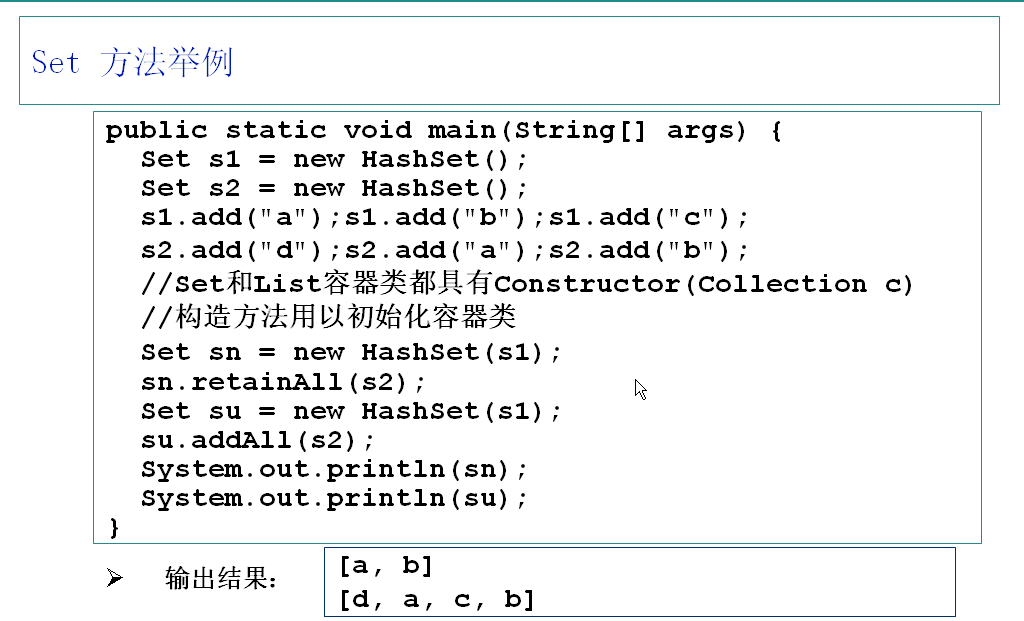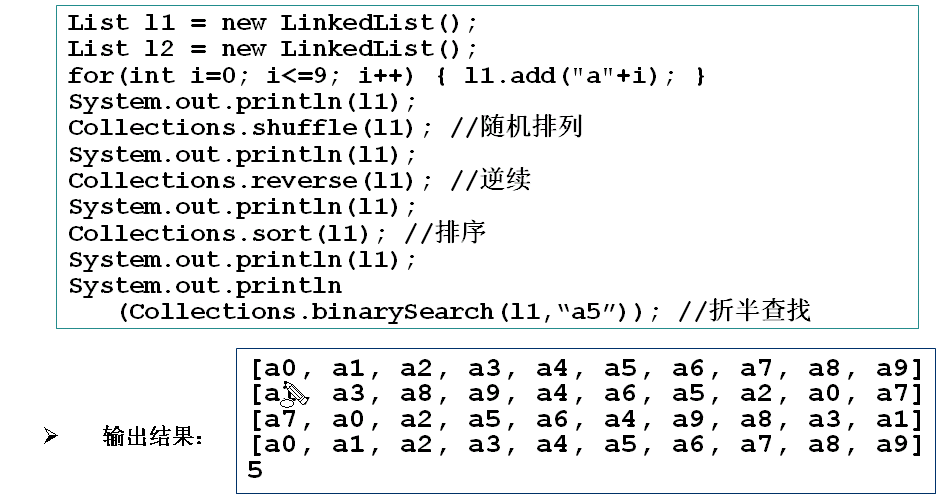[转] Java中的容器
在书写程序的时候,我们常常需要对大量的对象引用进行管理。为了实现有效的归类管理,我们常常将同类的引用放置在同一数据容器中。
由于数据容器中存放了我们随时可能需要使用到的对象引用,所以一般的数据容器要都要能能提供方便的查询、遍历、修改等基本接口功能。
早期的OOP语言都通过数组的方式来实现对引用集的集中管理和维护。
但是数组方式下,数组大小需要提前被确定,并不允许修改大小,导致其作为一种灵活的数据容器的能力的功能大为下降。
为了方便的利用数据容器进行引用的管理,Java中提供了丰富的数据容器以满足程序员多样化的需求。
JAVA的容器---List,Map,Set
Collection
├List
│├LinkedList
│├ArrayList
│└Vector
│ └Stack
└Set
Map
├Hashtable
├HashMap
└WeakHashMap
!其中的Vector和Stack类现在已经极少使用。

从容器类图中可以发现,数据容器主要分为了两类:
Collection: 存放独立元素的序列。
Map:存放key-value型的元素对。(这对于一些需要利用key查找value的程序十分的重要!)
从类体系图中可以看出,Collection定义了Collection类型数据的最基本、最共性的功能接口,而List对该接口进行了拓展。
其中各个类的适用场景有很大的差别,在使用时,应该根据需要灵活的进行选择。此处介绍最为常用的四个容器:
LinkedList :其数据结构采用的是链表,此种结构的优势是删除和添加的效率很高,但随机访问元素时效率较ArrayList类低。
ArrayList:其数据结构采用的是线性表,此种结构的优势是访问和查询十分方便,但添加和删除的时候效率很低。
HashSet: Set类不允许其中存在重复的元素(集),无法添加一个重复的元素(Set中已经存在)。HashSet利用Hash函数进行了查询效率上的优化,其contain()方法经常被使用,以用于判断相关元素是否已经被添加过。
HashMap: 提供了key-value的键值对数据存储机制,可以十分方便的通过键值查找相应的元素,而且通过Hash散列机制,查找十分的方便。
该类图的理解,对于灵活的使用相应的数据容器十分的重要。
根据Oracle公司的官方文档:
1、Collection是对Iterable接口的拓展。故所有的Collection对象都可以使用foreach方式,对元素进行方便的遍历。
由于Iterable接口中定义了的唯一方法为:返回一个Iterator对象,故所有的Collection都可以用 对象名.iterator()的方式获取该collection的迭代器iterator对象(结合工厂方法和内部类的思想来理解,其作用十分大)
2、Map中提供了产生Collection的方法,以支持方便的对键值对的值域进行操作。
Collection<V> values() Returns:a collection view of the values contained in this map.
从JAVA提供的数据容器来看,可以清晰的认识到面向对象的思想在类的架构设计中的重要性。
灵活的使用好各类容器类,以最大限度的提升程序的性能。由于类型过多,大多的基础操作都被抽象到了Collection中,熟练并利用好Collection提供的接口,已经可以解决大量的问题(即使是Map,其也提供了产生Collection对象的机制)。
Example:
public class TestContainer { Collection<String> testList= new ArrayList<String>(Arrays.asList("i love you".split(" "))); Map<Integer, String> testMap=new HashMap<Integer, String>(); TestContainer() { testMap.put(1, "I"); testMap.put(2, "love"); testMap.put(3, "you"); print(testMap); print(testList); print("Using Iterable Interface"); for(String str:testList) { print(str); } print("Geting the values collection of a Map"); Collection<String> mapValues= testMap.values(); for(String str:mapValues) { print(str); } print("Geting the Iterator of a collection"); Iterator i=mapValues.iterator(); while(i.hasNext()) { print(i.next()); } } }
以上的例子中,TestContainer的实例会有连个数据成员:
1、ArrayList<String> testList
2、Map<Integer, String> testMap
为了对ArrayList进行遍历,此例中直接将ArrayList向上转型为了Collection类型(结合类图),并利用foreach遍历方式对其中的成员进行了遍历。
为了对Map中的value域进行访问,此处调用了Collection<String> mapValues= testMap.values(); ,使用Map的values()方法返回了其value成员的Collection对象。
于是可以像操纵其它Collection一样,对该集合进行操作!
容器是用来保存多个对象的东西.严格来说是保存对象的引用.因为对象实际的数据是放在另外的地方的.放在容器中的只是指向那块内存区域的一个标识.
import java.util.*; public class TestArrayList{ public static void main(String args[]){ List<String> li=new ArrayList<String>(); String s="hello"; li.add(s); s="world"; li.add(s); for(int i=0;i<li.size();i++){ System.out.println(li.get(i)); } } }
s指向的内容改变,容器里面保存的是引用,为什么不跟着改变?怎么输出还是“hello”、“world”?
为什么不是“world”、“world”?
第二次加的是“world”对象的引用,和变量s的名字无关
容器API:
1、Collection接口------定义了存储一组对象的方法,其子接口Set和List分别定义了存储的方式。
①、Set中的数据对象没有顺序且不可以重复。
②、List中的数据对象有顺序且可以重复。
2、Map接口定义了存储“键(key)---值(value)映射对”的方法。
Collection接口:
Collection接口中定义的方法(意思就是只要你实现了Collection接口,你将拥有下面所有方法):

Collection方法举例:
这里要说明的就是集合里面只能装引用类型的数据。
import java.util.*;
public class TestCollection{
public static void main (String args[]){
Collection collection = new ArrayList();
//可以放入不同类型的对象
collection.add("hello");
collection.add(new Person("f1",18));
collection.add(new Integer(100));
System.out.println(collection.size());
System.out.println(collection);
}
}
class Person{
private String name;
private int age;
public Person(String name,int age){
this.name = name;
this.age = age;
}
}
接下来,我们继续使用上面的例子,说说Collection里面remove()方法的使用:
import java.util.*;
public class TestCollection{
public static void main (String args[]){
Collection collection = new HashSet();
//可以放入不同类型的对象
collection.add("hello");
collection.add(new Person("f1",18));
collection.add(new Integer(100));
collection.remove("hello");
collection.remove(new Integer(100));
System.out.println(collection.remove(new Person("f1",18)));
System.out.println(collection);
}
}
class Person{
private String name;
private int age;
public Person(String name,int age){
this.name = name;
this.age = age;
}
public String getName(){
return name;
}
public int getAge(){
return age;
}
/*public boolean equals(Object obj){
if(obj instanceof Person){
Person person = (Person)obj;
return (name.equals(person.name) && age == person.age);
}
return super.equals(obj);
}
public int hashCode(){
return name.hashCode();
}*/
}
执行上面的例子,你会发现我们插入的数据”hello“和new Integer(100)都可以用remove()方法直接删除,但是对于new person("f1",18)这对象可以用remove()方法直接删除吗?答案是不可以的....
容器类对象在调用remove、contains等方法时需要比较对象是否相等,这会涉及到对象类型的equals方法和hashCode方法;对于自定义的类型,需要重写equals方法和hashCode方法以实现自定义对象相等规则。
注意,相等的对象应该具有相等的hash Codes
Ieterator接口(简单说:Iterator就是一个统一的遍历我们集合中所有元素的方法)
1、所有实现了Collection接口的容器类都有一个iterator方法用以返回一个实现了Iterator接口的对象。
2、Iterator对象称作迭代器,用以方便的实现对容器元素的遍历实现。
3、Iterator实现了下列方法:

下面我们写一个用Iterator遍历集合元素的方法。(注:程序运行信息输出顺序可能跟我们输入的顺序不一致,这就是Set集合无序的效果)
import java.util.*;
public class TestCollection{
public static void main (String args[]){
Collection collection = new HashSet();
collection.add(new Person("zhang",1));
collection.add(new Person("gao",2));
collection.add(new Person("wang",3));
collection.add(new Person("du",4));
collection.add(new Person("liang",5));
collection.add(new Person("li",6));
Iterator iterator = collection.iterator();
while(iterator.hasNext()){
//next()的返回值类型是Object类型,需要转换为相应类型
Person person = (Person)iterator.next();
System.out.println(person.name);
}
}
}
class Person{
public String name;
private int age;
public Person(String name,int age){
this.name = name;
this.age = age;
}
public String getName(){
return name;
}
public int getAge(){
return age;
}
}
Set接口
1、Set接口是Collection的子接口,Set接口没有提供的额外方法,但实现Set接口的容器类中的元素是没有顺序的,而且不可以重复
2、Set接口可以与数学中”集合“的概念相对应。
3、J2SDK API中所提供的容器类有HashSet、TreeSet等...
Set方法举例:

Set方法举例:

List接口:
1、List接口是Collection的子接口,实现List接口的容器类中元素是有顺序的,而且可以重复。
2、List容器中元素都对应一个整数型的序号记载其在内容中的位置,可以根据序号存取容器中的元素。
3、L2SDK所提供的List容器类有ArrayList,LinkedList等...
List 方法举例:

List常用算法:

List常用算法举例:





